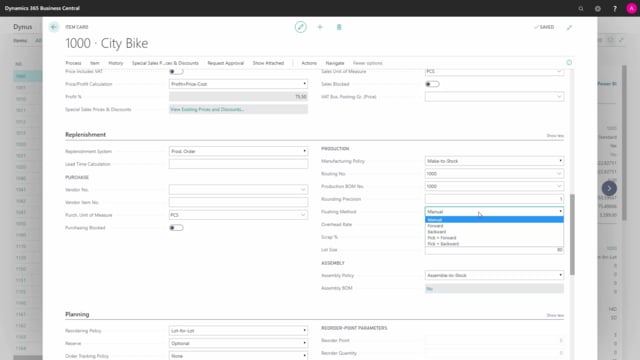
How to work with item fields in Business Central as a production department?
On the item card in Business Central we have a lot of fields for the production department that are relevant on the replenishment tab, actually we also have a lot of fields on the planning tab that are normally used by people in the production but, it’s actually planning parameters.
This is what happens in the video
So for the actual production, creating production order functionality, you use the fields on the replenishment tab so all those fields, I will use if the replenishment system is chosen as a production order.
First of all we have the manufacturing policy, I think that almost all our clients are using “make to stock”, meaning reproducing the item and put it on stock, whereas the “make to order”, you can make the production order be directly combined with the sales order, and instead of having a source expression that is the item number, the source expression will be the sales order number.
And with “make to order” functionality, you could also have more than one production order line on each production order.
Normally we experience that our customer would like to have one item per production order to produce.
On the production order you have the routing and the bill of material routing, meaning the way we persist the item with the operations or the work centers, machine centers, that we need to set up, and the production BOM is the ingredients in our kitchen, all the stuff we need to produce this item, and if we just shortly display a production order, you go into a specific setup were you define a list of items quantity per etc., likewise the routing is a separate setup so you can use one production order or one routing on several items, like in our demo data, we have this production BOM number and the same routing number for many of the top-level bikes.
Then you can define a rounding position, that you use in the production department when suggesting output of this item and the flushing method defines whether the item should be flushed automatically when releasing the production order, meaning all the components.
Then you have the flushing method on how the item should be flushed for the production order, so if the flushing method is forward this item would be flushed automatically from a consumption journal, when releasing the production order, whereas if it’s manually you would normally flush it from a consumption journals, so it’s manually flushed, and if it’s backwards it’s automatically flushed when you finish the production order, based on the actual output.
So the most precise inventory is of course given if you flush it manually and create the consumption journal.
The overhead rate is a fixed amount that you can add to the item to put on top of the item standard cost, when you calculate the standard cost price for this item, and it’s normally meant to cover all the indirect cost on the production area, meaning maintenance of the machinery maybe and an overhead cost, that are specifically related to this item when producing it.
The scrap percentages, could be set up, and also affect the calculation of the standard cost and it will make the consumption amount on the production order be higher, if you have a fixed scrap percentage on the item card, so you will expect to scrap some of them, when producing it.
And last of all you have the lot size, which displays, or should display, the normal quantity we produce this item in, and it’s relevant for calculating the standard cost price because the set up time on the production order or the set up time on the routing will be split into the lot size amount, when calculating the standard cost.
So this is the fields relevant for production people.

